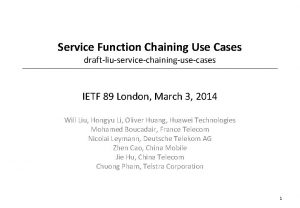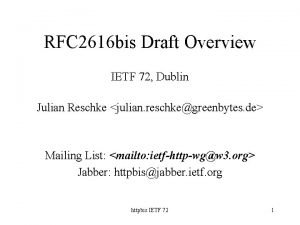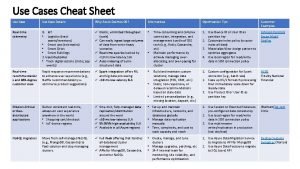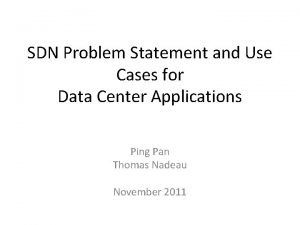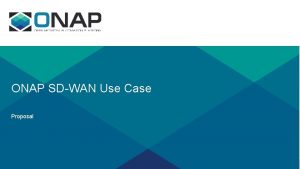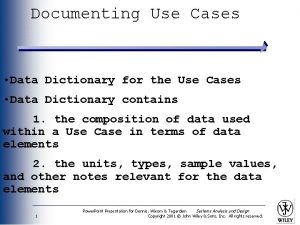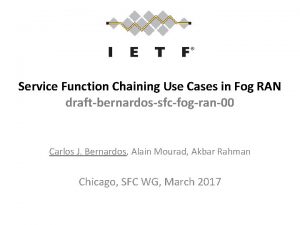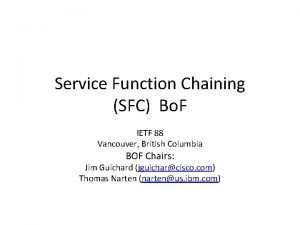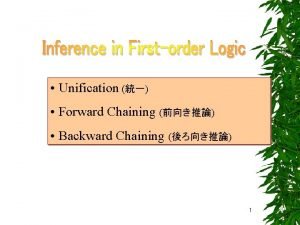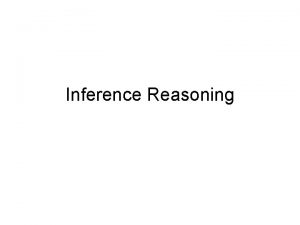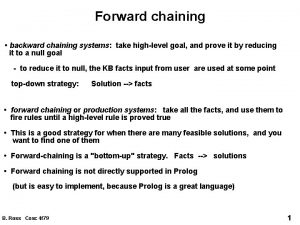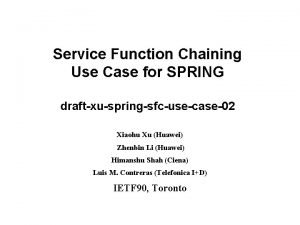Service Function Chaining Use Cases draftliuservicechainingusecases IETF 89













- Slides: 13

Service Function Chaining Use Cases draft-liu-service-chaining-use-cases IETF 89 London, March 3, 2014 Will Liu, Hongyu Li, Oliver Huang, Huawei Technologies Mohamed Boucadair, France Telecom Nicolai Leymann, Deutsche Telekom AG Zhen Cao, China Mobile Jie Hu, China Telecom Chuong Pham, Telstra Corporation 1

Overall Context & Objective • The delivery of value-added services relies on the invocation of advanced Service Functions (SFs) in a given order • The traffic is forwarded through a set of SFs for specific purposes, such as: – Direct a portion of the traffic to a Network Element for monitoring or charging – Steer the traffic to cross a load balancer before DC servers – Split mobile broadband traffic and steer them along an offloading path – Filter the traffic for Intrusion Detection System /Intrusion Protection System – Parental Control, Malware Protection services, Video Optimization … • This draft introduces a set of SFC Use Cases IETF 89 2

General Observations (1) • Instantiated chains are driven by business and engineering needs • The amount of instantiated SFCs can vary in time, depending on the service engineering objectives and service engineering choices • The amount of instantiated SFCs are policy-driven and are local to each administrative entity • The technical characterization of each Service Function is not frozen in time – A Service Function can be upgraded to support new features or disable an existing feature, etc. IETF 87 - 29 July 2013 3

General Observations (2) • Some stateful SFs (e. g. , NAT or firewall) may need to treat both outgoing and incoming packets – The design of SF Maps must take into account such constraints, otherwise, the service may be disturbed. The set of SFs that need to be invoked for direction is up to the responsibility of each administrative entity operating an SFC-enabled domain • For subscription-based traffic steering, subscriberawareness capability is required • Some Service Functions may be in the same subnet; while others may not • Service Functions are deployed directly on physical hardware, as one or more Virtual Machines, or any combination thereof IETF 87 - 29 July 2013 4

Rationale of the Document • Identify a set of SFC use cases • For each use case, provide description with a focus on specific considerations to be considered during the SFC design phase • It is not the purpose of this document to be exhaustive. . but instead – Draw the set of deployments context that are likely to see SFC solutions deployed IETF 87 - 29 July 2013 5

Typical SFC Use Cases • This draft describes a set of scenarios for SFC deployment – – – Use Case of Service Function Chain in Broadband Network Use Case of Service Function Chain in Mobile Networks: The Gi/SGi Interface Use Case for Distributed Service Function Use Case of Service Function Chain in Data Center Use Cases of Service Function Chaining Technical Scenario • This draft also describes SFC use cases from technical view – – – Use Case for Service Function Chain with NAT Function Use Case for Multiple Underlay Networks Use Case of Service Path Forking Use Case of Multiple Service Paths Share one Service Function Use Case of Service Layer Traffic Optimization IETF 89 6

Typical SFC Use Case: Broadband Network • In broadband networks, an operator may deploy value-added service nodes on POP (Point of Presence) site. • The figure illustrates a possible deployment position for Service Function Chaining: between BNG and CR (Core Router). • The Service Function Chain may include several Service Functions to perform services such as DPI, NAT 44, DS-Lite, NPTv 6, Parental control, Firewall, load balancer, Cache, etc. IETF 89 7

Typical SFC Use Case: Mobile Networks • The traffic from GGSN/PGW to Internet can be categorized and directed into the following SFCs by DPI: – Chain 1: WAP GW. DPI performs traffic classification function, recognizes WAP protocol traffic, and directs these traffic to the WAP GW through Service Function Chain 1. – Chain 2: Optimizer + cache + Firewall + NAT. DPI recognizes and directs the HTTP traffic to the Optimizer, Cache, Firewall and NAT in order, to perform HTTP video optimization, HTTP content cache, firewall and NAT function, respectively. – Chain 3: Firewall +NAT. For other traffic to the Internet, DPI directs these traffic by Service Function Chain 3, the traffic would travel the firewall and NAT in order. IETF 89 8

Next Step • The draft has benefited from a large review – Many thanks to the reviewers • We have addressed comments from the reviewers – Several iterations of the draft so far • We do think the document is ready for WG adoption – Positive feedback from the mailing list to adopt this draft as starting point: http: //www. ietf. org/mail-archive/web/sfc/current/msg 00966. html – Adopt as a WG item? • Any question? IETF 89 9

SFC Deployment Use Case: Data Center • The figure illustrates a possible scenario for Service Function Chain in Data Center: SFs are located between the DC Router (access router) and the Servers. • From Servers to Internet, there are multiple Service Functions such as IDS/IPS, FW, NAT lined up and a monolithic SFC created for all incoming traffic. IETF 89 10

SFC Traffic Steering Use Case: • In an operator's network, some Service Functions are implemented, where traffic is steered through these Service Functions in a certain sequence according to service characteristics and objectives. • Traffic enters a SFC-enabled domain in a service classifier, which identifies traffic and classifies it into service flows. Service flows are forwarded on a per SF Map basis. IETF 89 11

SFC Traffic Steering Use Case: • When a DPI function is part of a Service Function Chain, packets processed by the DPI function may be directed to different paths according to result of DPI processing, often leading to a forking service path. • In the figure, traffic first goes through a firewall and then arrives at DPI function which discerns virus risk. If a certain pre-configured pattern is matched, the traffic is directed to an anti-virus function. IETF 89 12

SFC Traffic Steering Use Case: • Some carrier grade hardware box or Service Functions running on high performance servers can be shared to support multiple Service Function Chains. • In the figure, there are three Service Functions, firewall, Video. Opt and Parental Control, and two Service Functions Chains SFC 1 and SFC 2. – SFC 1 serves broadband user group 1 which subscribes to secure web surfing and Internet video optimization – SFC 2 serves broadband user group 2 which subscribes to secure web surfing with parental control. SF Firewall is shared by both Service Function Chains IETF 89 13
 Service chaining use cases
Service chaining use cases Backward chaining
Backward chaining Criminal cases vs civil cases
Criminal cases vs civil cases Ietf rfc 2616
Ietf rfc 2616 Greenware ceramics definition
Greenware ceramics definition How to write use cases
How to write use cases Writing effective use cases by alistair cockburn
Writing effective use cases by alistair cockburn Cosmos db cheat sheet
Cosmos db cheat sheet Use case description adalah
Use case description adalah Couchbase use cases
Couchbase use cases Sdn use case
Sdn use case Sd wan proposal
Sd wan proposal Documenting use cases
Documenting use cases Hyperledger use cases
Hyperledger use cases
